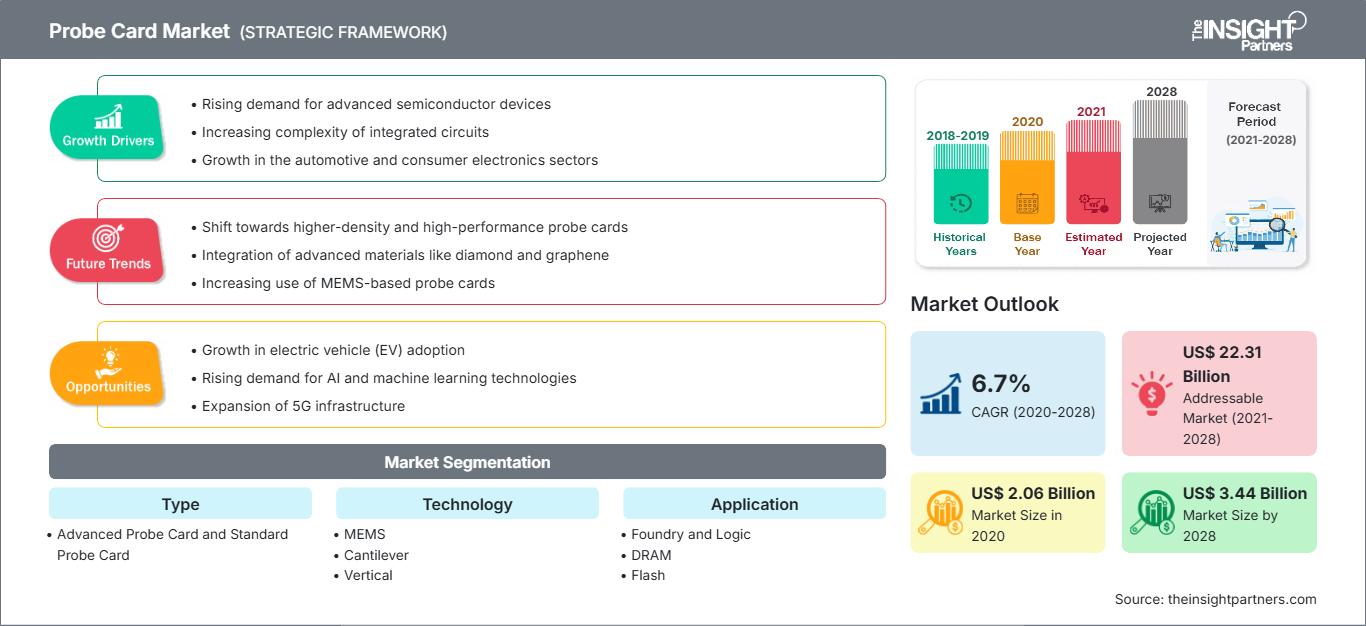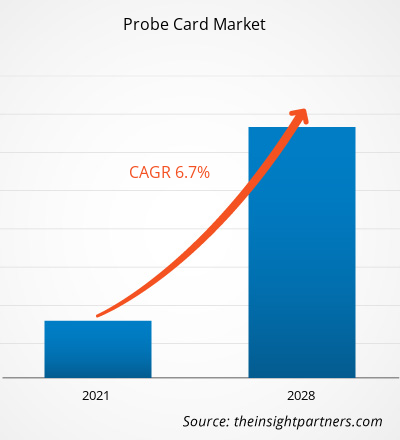Si prevede che il mercato delle schede di prova raggiungerà i 3.436,80 milioni di dollari entro il 2028, rispetto ai 2.059,80 milioni di dollari del 2020; si prevede inoltre una solida crescita del mercato con un CAGR del 6,7% nel periodo 2021-2028.
Una scheda di prova è un'interfaccia che consente di testare un wafer di semiconduttore. Nella fase iniziale della produzione di semiconduttori, questa procedura viene utilizzata per valutare la qualità dei circuiti integrati o dell'indicizzazione semantica latente. Nella maggior parte dei casi, la scheda di prova è agganciata meccanicamente a un prober e collegata elettricamente a un tester. Lo scopo principale di una scheda di prova è stabilire una connessione elettrica tra l'apparecchiatura di prova e i circuiti sul wafer, consentendo il test dei circuiti. I componenti fondamentali delle schede di prova sono i circuiti stampati (PCB) e vari tipi di elementi di contatto. Una scheda di prova considera una varietà di elementi, alcuni dei quali sono piuttosto comuni e altri con un uso altamente specifico.
Il settore dell'elettronica di consumo si è evoluto a seguito del crescente utilizzo di cellulari, computer desktop, fotocamere digitali, tablet, laptop, hard disk e televisori, tra gli altri, nonché della costante ricerca e introduzione di nuove tecnologie. L'introduzione di gadget intelligenti e dell'Internet of Things, così come la crescente accettazione dei tablet e l'impennata della domanda di dispositivi con schermi di grandi dimensioni, stanno tutti contribuendo alla crescita del mercato delle sonde. La domanda di semiconduttori è stata alimentata dai cambiamenti nelle tendenze delle dimensioni dei chip e da una crescente preferenza per l'architettura creativa in vari prodotti elettronici. Le crescenti dimensioni della produzione di chip per circuiti integrati hanno portato a un boom nella domanda di test elettronici, che sta aumentando la necessità di schede di prova. L'integrazione di tecnologie moderne, come l'intelligenza artificiale e l'IoT, nelle apparecchiature di produzione dei semiconduttori ne accelererà l'accettazione negli stabilimenti di fabbricazione. Inoltre, la crescente domanda di sensori al silicio per i dispositivi IoT, l'espansione della presenza dell'industria dei chip nei paesi emergenti e l'aumento del numero di data center e server sono fattori che contribuiscono ad aumentare le prestazioni dell'industria dei semiconduttori, che a loro volta contribuiscono a sondare la domanda di schede.
Il lockdown mondiale per ridurre al minimo la trasmissione del virus ha interrotto significativamente le attività della catena di approvvigionamento e i volumi di produzione di diversi produttori, in particolare delle piccole e medie imprese. L'industria dei semiconduttori ha subito un duro colpo a causa del calo della domanda di componenti elettronici da parte del settore industriale e degli utenti finali. Il modello di fatturato per la microelettronica è diminuito a causa dell'assenza di produzione di massa durante il periodo di lockdown. Dopo il lockdown, l'industria dei semiconduttori ha iniziato a riconquistare quote di mercato con la ripresa delle attività degli impianti di produzione adottando misure di distanziamento sociale. Inoltre, il lavoro da casa e le strategie di monitoraggio remoto hanno contribuito ad aumentare le vendite di prodotti elettronici avanzati per una migliore connettività. L'importanza dell'IT e delle telecomunicazioni è stata evidenziata ai fini della comunicazione, consentendo al settore di evolversi con nuove tecnologie come la connettività IoT e la tecnologia di packaging compatibile con Wi-Fi ad alta velocità.
Personalizza questo rapporto in base alle tue esigenze
Potrai personalizzare gratuitamente qualsiasi rapporto, comprese parti di questo rapporto, o analisi a livello di paese, pacchetto dati Excel, oltre a usufruire di grandi offerte e sconti per start-up e università
Mercato delle carte sonda: Approfondimenti strategici

- Ottieni le principali tendenze chiave del mercato di questo rapporto.Questo campione GRATUITO includerà l'analisi dei dati, che vanno dalle tendenze di mercato alle stime e alle previsioni.
Potrai personalizzare gratuitamente qualsiasi rapporto, comprese parti di questo rapporto, o analisi a livello di paese, pacchetto dati Excel, oltre a usufruire di grandi offerte e sconti per start-up e università
Mercato delle carte sonda: Approfondimenti strategici

- Ottieni le principali tendenze chiave del mercato di questo rapporto.Questo campione GRATUITO includerà l'analisi dei dati, che vanno dalle tendenze di mercato alle stime e alle previsioni.
In base al rapporto di mercato sulle schede di controllo, si prevede che l'Asia-Pacifico deterrà la maggioranza della quota di mercato globale delle schede di controllo. L'Asia-Pacifico comprende le economie più grandi e dinamiche come Cina, India, Giappone, Australia e Corea del Sud. Taiwan, Cina e Giappone sono i principali produttori di semiconduttori nell'area Asia-Pacifico. L'aumento del reddito disponibile nei paesi in via di sviluppo come India e Cina sta creando un'ampia base di clienti per l'elettronica di consumo ad alta tecnologia, come dispositivi indossabili intelligenti, smartphone e veicoli elettrici. Si prevede che questo fattore guiderà il mercato delle schede di controllo nella regione. La Cina è un importante polo produttivo per i prodotti basati sulla tecnologia di packaging dei circuiti integrati, mentre Taiwan, Corea del Sud e Giappone contribuiscono in modo significativo alla crescita del mercato regionale. Molti paesi dell'area Asia-Pacifico sono caratterizzati dalla produzione di massa di dispositivi elettronici necessari per l'elettronica di consumo, componenti automobilistici, dispositivi di telecomunicazione e altri macchinari industriali. Il crescente numero di aziende manifatturiere di elettronica in India e Cina, grazie alla forte disponibilità di risorse umane qualificate, sta trainando la crescita del mercato delle schede di controllo.
Segmenti di mercato delle schede di controllo
In base all'analisi del mercato delle schede di controllo, il mercato è segmentato in base a tipologia, tecnologia, applicazione e area geografica. In base alla tipologia, il mercato delle schede di controllo è segmentato in schede di controllo avanzate e schede di controllo standard. In base alla tecnologia, il mercato delle schede di controllo è segmentato in MEMS, cantilever e verticali. In base all'applicazione, il mercato delle schede di controllo è segmentato in fonderia e logica, DRAM, flash e altri. L'analisi geografica è condotta in base a regioni come Nord America, Europa, Asia Pacifico (APAC) e Resto del mondo (RoW).
Alcuni dei principali attori del mercato delle schede di controllo sono FEINMETALL GmbH; FormFactor; Fujitsu; GGB Industries; Japan Electronic Materials Corporation; Korea Instrument Co.,Ltd.; Micronics Japan Co., Ltd.; MPI Corporation; SV Probe; e Technoprobe SpA
Approfondimenti sul mercato delle schede sonda basate sul tipo
In base al tipo, il mercato globale delle schede sonda è segmentato in schede sonda avanzate e schede sonda standard. La scheda sonda è un'interfaccia, o una scheda, utilizzata per eseguire test su wafer per semiconduttori. Esistono essenzialmente tre tipi di test che vengono eseguiti utilizzando una scheda sonda: test CC, test CA e test funzionale.
Mercato delle schede sondaMercato delle carte sonda
Le tendenze regionali e i fattori che influenzano il mercato delle schede di prova durante il periodo di previsione sono stati ampiamente spiegati dagli analisti di The Insight Partners. Questa sezione illustra anche i segmenti e la geografia del mercato delle schede di prova in Nord America, Europa, Asia-Pacifico, Medio Oriente e Africa, America meridionale e centrale.
Ambito del rapporto di mercato delle schede sonda
| Attributo del rapporto | Dettagli |
|---|---|
| Dimensioni del mercato in 2020 | US$ 2.06 Billion |
| Dimensioni del mercato per 2028 | US$ 3.44 Billion |
| CAGR globale (2020 - 2028) | 6.7% |
| Dati storici | 2018-2019 |
| Periodo di previsione | 2021-2028 |
| Segmenti coperti |
By Tipo
|
| Regioni e paesi coperti | Nord America
|
| Leader di mercato e profili aziendali chiave |
|
Densità degli attori del mercato delle schede di prova: comprendere il suo impatto sulle dinamiche aziendali
Il mercato delle schede di controllo è in rapida crescita, trainato dalla crescente domanda degli utenti finali, dovuta a fattori quali l'evoluzione delle preferenze dei consumatori, i progressi tecnologici e una maggiore consapevolezza dei vantaggi del prodotto. Con l'aumento della domanda, le aziende stanno ampliando la propria offerta, innovando per soddisfare le esigenze dei consumatori e sfruttando le tendenze emergenti, alimentando ulteriormente la crescita del mercato.

- Ottieni il Mercato delle carte sonda Panoramica dei principali attori chiave
I player profilati nel rapporto di mercato delle schede di sonda si concentrano principalmente sullo sviluppo di prodotti avanzati ed efficienti. Le aziende del mercato delle schede di sonda stanno implementando diverse strategie per adattarsi ai progressi tecnologici nel mercato delle schede di sonda.
- Nel 2020, FormFactor ha annunciato la famiglia di sonde criogeniche per applicazioni informatiche emergenti.
- Nel 2020, Technoprobe ha acquisito Microfabrica.
- Analisi storica (2 anni), anno base, previsione (7 anni) con CAGR
- Analisi PEST e SWOT
- Valore/volume delle dimensioni del mercato - Globale, Regionale, Nazionale
- Industria e panorama competitivo
- Set di dati Excel
Report recenti
Testimonianze
Motivo dell'acquisto
- Processo decisionale informato
- Comprensione delle dinamiche di mercato
- Analisi competitiva
- Analisi dei clienti
- Previsioni di mercato
- Mitigazione del rischio
- Pianificazione strategica
- Giustificazione degli investimenti
- Identificazione dei mercati emergenti
- Miglioramento delle strategie di marketing
- Aumento dell'efficienza operativa
- Allineamento alle tendenze normative




















 Ottieni un campione gratuito per - Mercato delle carte sonda
Ottieni un campione gratuito per - Mercato delle carte sonda